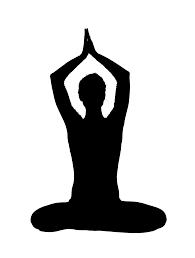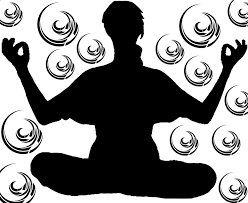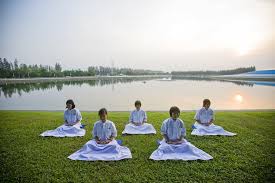 When someone is beginning to explore meditation, it’s often somewhat confusing which style to actually do. There are seemingly endless options, ranging from the world’s major spiritual traditions to more secular approaches to individual teachers with their own “innovative” style.
When someone is beginning to explore meditation, it’s often somewhat confusing which style to actually do. There are seemingly endless options, ranging from the world’s major spiritual traditions to more secular approaches to individual teachers with their own “innovative” style.
For example, there’s Zen buddhism, Vipassana, Yogic meditation, Taoist meditation, Christian meditation, secular mindfulness groups, heart-centered meditation, Advaita Vedanta and countless fusions or other integrative approaches.
Of course, all these approaches to meditation are getting at something similar, and yet they’re also quite distinct. In today’s post, I hope to give some clarity on the basic framework underlying all meditative practices.
May this benefit you and your journey into yourself!
 The Two Basic Questions Of Any Meditation Practice
The Two Basic Questions Of Any Meditation Practice
1) What do I actually do?
2) What is the purpose of doing that? (aka why?)
For starters, if we know what to do and we actually do it, then many of the benefits will come even if we have no idea what the purpose is.
For example, we go to a yoga class and at the end the teacher leads a 10 minute guided meditation. If we actually do what they are instructing, there’s a real good chance we’ll feel peaceful and relaxed. This isn’t the ultimate purpose of Yogic meditation, but it is a pretty solid benefit.
The most important thing is knowing what to do and actually doing it.
However, imagine we went on a long yogic retreat or spent 20 years regularly practicing yoga. If we were keenly aware of the ultimate purpose—developing “stability of mind” to the end of realizing the difference between self and ego, and thus becoming free—we would be able to steer our practice in that direction. This steering would help us more skillfully navigate obstacles, keep us motivated and, above all, make it more likely that we’ll actually fulfill that purpose.
In other words, even though doing it is most important, having a sense of direction is extremely helpful in the long run.
 Diving Deeper into the Purpose of Meditation
Diving Deeper into the Purpose of Meditation
The Buddha defined meditation as “cultivation.”
Similar to how physical fitness practices cultivate “beautiful body states,” like strong muscles or a robust heart, meditation is a mental-emotional fitness practice, which cultivates “beautiful inner states,” like compassion, joy, wisdom, contentment or focus.
If we think of meditation not just as what we are doing, but also as the purpose of what we are doing, it makes sense how people use the term meditation so loosely. For example, I’ve heard people say all of the following things were meditation:
Rock climbing, gardening, running, praying, deeply reflecting on life, playing chess, giving gifts, visualizing, observing raw body sensations, being mindful of the breath, and on and on.
If we’re looking at meditation as cultivating beautiful inner states, then rock climbing would be a meditation if it primarily cultivated perseverance, focus and courage. It would not be a meditation if it primarily cultivated pride, craving and aggression.
The same goes with formal sitting meditation.
Imagine a beautiful Zen Meditation room filled with three people sitting quietly with their legs crossed. The first one is maintaining a decent but not perfect present moment awareness, cultivating equanimity, presence and wisdom. The second one is intentionally thinking loving thoughts, one after the other, cultivating compassion and kindness. The third one is aimlessly ruminating on all the people they hate the most.
Of course, only the first two are actually meditating—or, cultivating beautiful inner states.
In other words, it’s important to realize what exactly we are trying to cultivate. Do we just want to relax? Do we want inner freedom? Do want more self-love? Do we want courage?
If we know why we are meditating, we can more easily channel our efforts to actually do it—and, importantly, we can choose the particular “meditations” that most powerfully cultivate the thing we want.

The Three Different Ways to “Do” Meditation
1. Action. Like rock climbing, gardening or doing one’s daily tasks with an attitude of service and kindness (karma yoga).
2. Intentional Thinking. Like Buddhist Loving-Kindness meditation (metta), Tibetan Compassion meditation (tonglen), Christian prayer, philosophical introspection or “positive thinking.”
3. Present moment awareness. Like secular mindfulness, Christian centering or Yogic, Taoist, Buddhist and Transcendental Meditation. All of these drop beneath our inner dialogue and notice what’s happening right now via body sensations, sounds, tastes, smells, sights or mental-emotional events.
Apart from purpose, what unifies these three ways of “doing”?
If anyone has tried a present moment awareness style of meditation, like observing the breath, it’s easy to see how important focus is—if we can’t stay focused, then we’ll spending more time thinking than being aware.
Likewise, in the action and thinking styles of meditation, there’s an equal need for focusing on what we’re doing right now.
For example, if we can’t stay focused on our prayer, then we’re not meditating, we’re just drifting. Or, if we can’t stay focused while running, as soon as it gets challenging, we’re going to start believing all the thoughts that tell us to quit, and we’re going to stop.
In other words, the underlying unity of the “doing” side of all meditation styles is present moment focus.

Diving Deeper Into the Present Moment
This is usually the place where people begin their meditative search. For good reason—there is something extremely powerful about working directly with our inner reality. Like many people, when I talk about meditation, I’m usually exclusively referring to preset moment awareness practices. As such, the rest of this post is devoted to the life changing capacity of presence.
There are four basic ways we can “direct” our awareness in the present moment:
1) Focused Attention. This style picks one object and exclusively focuses attention on that object, ignoring anything else. For example, if we are focusing attention on the sensations of the breath, we ignore all sounds, sights, thoughts and other distractions. If by chance we become distracted, we instantly bring our attention back to the breath. Here’s a list of common focusing objects:
- A visual object, like a candle flame or a dot on the wall.
- A mental visualization, like a ball of light or the face of the Buddha.
- A specific body sensation, like a throbbing forehead or a tingling hand.
- The entire field of body sensations, like the sensory feel of the body as one unit.
- The breath, like the sensations in the abdomen, nostrils or the overall feel of the breath.
- A particular sound, like the chirping birds or the flow of a river.
- The entire field of sound, like the interplay of the birds, river, traffic and white noise.
- The sound of silence, like the subtle hum beneath all sound (try it with earplugs).
- A mantra, like noticing how it sounds or sinking into the act of repeating it.
- The thought stream, like noticing whether thoughts are visual, energetic or linguistic.
The list could go on and on, but all that matters is that it’s something you can be aware of in the present moment.
Note: something like “loving-kindness meditation” was previously listed as a “thinking” meditation. However, if it’s done primarily as a mantra, a series of repetitive phrases that pop us out of random thinking and ground us in the present, then it would also be a “focused attention” practice.
2) Open Monitoring. This style opens awareness to the entire flow of experience, without having a preferred object in the center. It tunes into how awareness bounces around all by itself, one moment being aware of a sound, the next of a sensation in the right foot, the next a thought, the next a sense of irritation, the next a feeling of warmth, and on and on.
This style teaches us that we don’t have to try hard to focus on just one thing because there are so many things happening. It essentially tries to mimic our everyday life, showing us that we can be aware all day long, no matter what is happening.
3) Anchored Awareness. This style is somewhere in-between the previous two. It “anchors” awareness in a single object, like the sensations of the breath, but doesn’t hold to it too tightly. It’s still aware of the objects in the periphery, like the sounds or thoughts flowing by. If another object becomes really prominent, like a pain in the knee, it might shift its “anchor” to the sensations in the knee for a little bit before eventually returning to the breath.
These previous three ways of “doing” present moment awareness could all be called “directed” awareness. They either direct it towards one object, towards all objects, or towards somewhere in the middle. The final style of “doing” is actually more of a “non-doing” or “undirected” awareness.
4) Effortless Awareness. This style is very similar to open monitoring in that it doesn’t have a preference for one specific object. However, the emphasis of open monitoring is on all the different objects to be aware of. In effortless awareness, the emphasis is on awareness itself. It might ask the questions, “what is it that’s aware right now?” or “what is the difference between awareness and blanking out?” or “is awareness happening right now?”
It begins by just recognizing the presence of awareness, whatever the objects, and ultimately stabilizes that sense of awareness until it’s effortless, rolling along all by itself.
Note: it’s extremely hard to just do effortless awareness (or even open monitoring) right away. It usually takes quite a bit of practice with either focused attention or anchored awareness in order to have enough mental stability to actually “do nothing” and still be aware.
 Bringing Together What & Why in Contemporary Traditions
Bringing Together What & Why in Contemporary Traditions
In order to explore what and why, let’s look at a handful of meditation approaches you’re likely to find nowadays.
1) What I teach
The entire Indian Tradition (Yoga/Hinduism, Buddhism and Vedanta) is rooted in the ultimate purpose of inner freedom. What we call secular mindfulness also has that as its purpose, without explicitly stating it.
Likewise, my teaching closely resembles Buddhist Vipassana meditation and uses present moment awareness for the purpose of inner freedom.
I usually start people with “anchored awareness” but try to give them a taste for “open monitoring” and “effortless awareness” early on. I want people to learn that meditation can happen with eyes open, all day long.
I encourage them to cultivate the beautiful inner qualities of relaxation, equanimity, non-distraction and curiosity. I also find that exposing unseen patterns of conditioning, thinking and emoting to be a very important part of the process, essentially bringing our shadows into the light (giving us more freedom/choice).
Here’s a post of the top six benefits I’ve experienced from meditating this way.
2) Classical Yoga & Hindu Meditation
There are many different styles of Yogic meditation, but the underlying principle is using focused attention on any number of objects to develop deeper and deeper levels of concentration—aka samadhi or jhana. In formal meditation, this leads to all the senses dropping away and an experience of absorption into pure consciousness. This experience is equated with liberation and inner freedom—the ultimate purpose of yoga.
On a day-to-day level, this practice leads to a more resolute focus and one-pointedness of mind. There aren’t as many scattered thoughts, and one has a palpable feel of presence all across the day.
3) Yogic Tantra, Kundalini, Pranayama & Mantra Meditation
Another major variant of Yogic meditation focuses on the flow of energy in the body. These approaches still use focused attention, but don’t just direct it to a random object—they channel it towards something specific.
In Yogic theory, the entire body is composed of energetic channels as well as seven energetic centers. One purpose of these types of meditation is to remove any blockages in the energetic system, allowing for a freer flow of energy.
Another purpose is to conjure up certain effects. This works because each energy center has different properties, like the root energy center being associated with groundedness and stability. And, so, if a meditator wanted to develop more groundedness, they could focus attention on the root energy center until that quality was more and more amplified.
Ultimately, all these energy-focused styles are getting at the same purpose as traditional Yogic meditation—they are activating the energetic field so strongly that the meditator begins to feel a constant state of absorption, climaxing in a liberation experience.
4) Buddhist Samatha Meditation
This style of meditation is essentially the same as classical Yoga meditation. It uses focused attention to the end of building deeper and deeper levels of concentration. Every tradition of Buddhism, from Zen to Vipassana to Tibetan, has some kind of samatha practice.
In Buddhism, the purpose of this meditation is twofold:
1) to relax the mind and become more peaceful and stable in the present moment
2) to prepare the mind for insight
In other words, in Yoga this type of meditation is the ultimate meditation, whereas in Buddhism it’s more of a stepping stone.
5) Buddhist Insight Meditation
Most schools of Buddhist meditation follow a similar trajectory: stabilizing awareness in the present moment (samatha), and then looking more closely so as to gain insight and inner freedom. There’s three specific present moment awareness insights that lead to inner freedom:
- Impermanence—every micro-second, our entire reality is changing—nothing is stable, solid or enduring.
- No-self—Perceiving very deeply the difference between awareness and objects of awareness—we are not our thoughts, world views, feelings, sensations or emotions (these are all objects).
- Suffering—it’s painful whenever we want this moment to be other than it is.
In practice, the various schools of Buddhist meditation can seem quite different. However, they are all still oriented around these three basic insights.
A) In Zen Buddhism, the overwhelming emphasis is on cultivating insight into no-self. Naturally, the practice is more about cultivating “effortless awareness.” Students may or may not start with samatha, but there’s a strong emphasis on all-day-long meditation, earthiness and non-doing.
In Soto Zen, the main practice is shikantaza, where you literally sit and do nothing except rest in effortless awareness. In Rinzai Zen, the main practice is Koans, where a teacher gives a student an unanswerable question, like, “what was the look of your face before you were born,” and then the student is supposed to hold that question in mind. Since it makes no sense, it essentially confusing them out of their thoughts and into effortless awareness—tricky!
B) In Tibetan Buddhism, there’s generally lots of emphasis on practicing samatha until a meditator is quite skilled at it. Similar to the Yogic energy traditions, there’s also many different practices to induce energetic effects. After these preliminary practices, the primary focus is on insight into no-self.
In the Dzogchen school, this is more directly an “effortless awareness” practice, putting all the emphasis on stabilizing that mode. In the Mahamudra school, there’s the similar “effortless awareness” practice, but also a bit of work with directive questions, like “what is the nature of mind?”
C) In Theravada / Vipassana Buddhism, one of the overarching strengths is a more pragmatic lens, with explicit instructions and a large inner vocabulary to discuss all the layers of subtler inner events. And yet, the feel of the practice is quite different among sub-traditions and teachers. For example:
The S.N. Goenka tradition does a little bit of samatha, but quickly switches to a body scanning technique to cultivate insight into impermanence. The Thai Forest tradition is more directed towards samatha, taking it to a high level before switching to “directed awareness” practices that build insight into any of the three insights. In the Mahasi tradition, a meditator starts with anchored awareness + mental labeling so as to gradually attain into any of the three insights; however, it’s strength is very specific techniques (mental labeling) to separate from the thinking process.
Then there are a handful of Vipassana teachers that don’t look anything like those three—my teacher, Sayadaw U Tejaniya, was more of an “effortless awareness” and “no-self” teacher, but still had the precise vocabulary of Vipassana.
In summary, Buddhist Insight Meditation is a very broad category with different sub-traditions and teachers that feel very different from one another. However, they are all rooted in developing inner freedom through present moment awareness.
6) Advaita Vedanta
This is a non-duality / oneness tradition that says our true self is the state of “effortless awareness.” It’s rooted deep in the Indian tradition, and that state of effortless awareness is said to equal inner freedom, the ultimate purpose. There are two basic methods:
A) Just submit. In other words, drop in effortless awareness and maintain it until it becomes our natural state.
B) Self-Inquiry. This likewise uses effortless awareness as a base, but also works with questions like, “who am I?” The theory is that since “I” must be continuous and always present, anything that changes or is non-constant can not be “I.” In turn, as we rest in effortless awareness, we begin to see that the different thoughts, feelings, body sensations and other senses are constantly in flux, and therefore can not be “I.” All that remains is awareness itself. This more profoundly we perceive this, the easier it is to stay rooted in effortless awareness.
There’s something refreshingly simple about this approach to meditation practice—it’s all reductive to effortless awareness, with no need for analysis or elaborate systems. Of course, like I said before, the only challenge is that unless one has done a fair bit of “directed awareness” practices, it’s really hard to actually rest in effortless awareness.
Check out Adyashanti’s “The Way of Liberation,” or Ramana Maharishi’s classic “Who am I?” text for concise explanations.
7) Taoist Meditation
I have very little personal experience with Taoist meditation, but a little internet research shows it has all the familiar components. There is the initial “focused attention” practice, commonly using the breath, which stabilizes the mind in the present. Also, similar to the energy Yogas and Tibetan Buddhism, there are also “focused attention” and movement practices that have special purposes, particularly using Qi Gong to open energy channels in the body.
Although, the highest practice is said to be “emptiness” meditation, which is an “effortless awareness” practice. The ultimate purpose of this is living in harmony. More specifically, when we are in “effortless awareness” we are solidly in the present and thus living in the vast web of interconnectedness. To live in harmony is to drop beneath our ego concerns, and to live simply and fluidly in this very moment.
The common phrase, “go with the flow,” directly stems from this tradition.
8) Transcendental Meditation
This practice is essentially “focused attention” using mantra. It exploded in popularity in the 60’s when The Beatles started practicing it, and is now clouded with secrecy and exorbitant fees.
I’ve sometimes wondered why people would even bother with it. Basically, it’s because a bunch of scientists latched onto it in the early days of meditation research, and as present moment practices work, it naturally generated lots of positive results. It’s also been fully secularized and has received many celebrity endorsements.
As the technique uses mantra, which is good for people who think a lot, this style will help them become more relaxed and peaceful (its basic purpose). However, any other tradition can also utilize mantra, so I would personally recommend against Transcendental Meditation.
9) Secular Mindfulness
This style of practice initially gained popularity with the eight week “Mindfulness Based Stress Reduction” courses created by Jon Kabat-Zinn. He based that course off of meditation training in the Buddhist tradition.
As a whole, secular mindfulness is essentially buddhist meditation stripped of all religiousness, dogma and the more advanced teachings only accessible to people with a very strong meditation practices.
The implicit purpose is “inner freedom,” but it often focuses on things like slowing down, simplicity, relaxing and making the mind more peaceful and present. It uses “focused attention” and “opening monitoring” practices, as well as loving-kindness meditation (which while powerful, is more of a thinking meditation.)
This is a great introduction for people to the power of present moment awareness.
10) Everything Else
There’s many traditions I’ve missed, but by this point you have a good idea of the underlying principles.
When you encounter a meditation style, is it some kind of directed attention or is it effortless awareness? Or, is it using some kind of action or thinking?
What is the ultimate purpose of that practice?
 How to Make Sense of it all
How to Make Sense of it all
You might now have a better sense of how the different meditation styles compare and contrast, and how they are all rooted in the questions of what you’re doing and why you’re doing it.
However, the question of which one to actually try out still remains!
The most important thing is to actually do something, rather than just sitting around thinking and reading about it. If you’ve gotten past that, I’d say go for one of the present moment awareness practices—they are more direct and more consistently produce results.
And if you can’t decide which present moment practice to try out, the best thing is to do what I did: just try a bunch of them out until you find out what resonates AND gives results.
Although, if time is limited and you’re wondering where to start, you might just go by which ones have decent teachers or established communities near your location. Or, you could just start with the approaches that seem to most match your temperament; for example, I’m a philosophically oriented guy, and Buddhist philosophy really works for me, which makes it a natural fit, but, say, a friend of mine who is a more earthy, feeling oriented fellow prefers the Taoist style.
But please don’t complicate all this—1 minute of meditation is worth 99 minutes of reading about it.
How will you put this information to use?

Thank you for the article. I have been practicing Tibetan for a couple of years now with Tergar. Before going deeper into their Mahamudra, I wanted to explore all the options. I found this article very helpful in understanding various meditation practices.